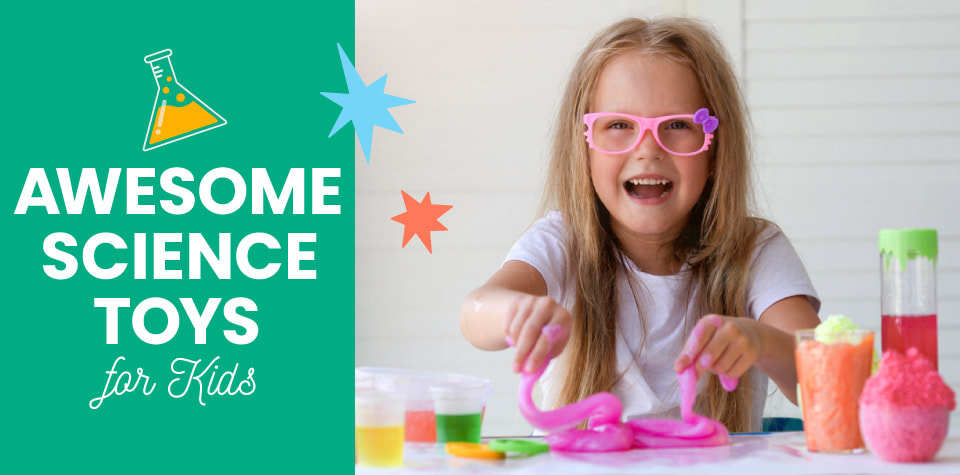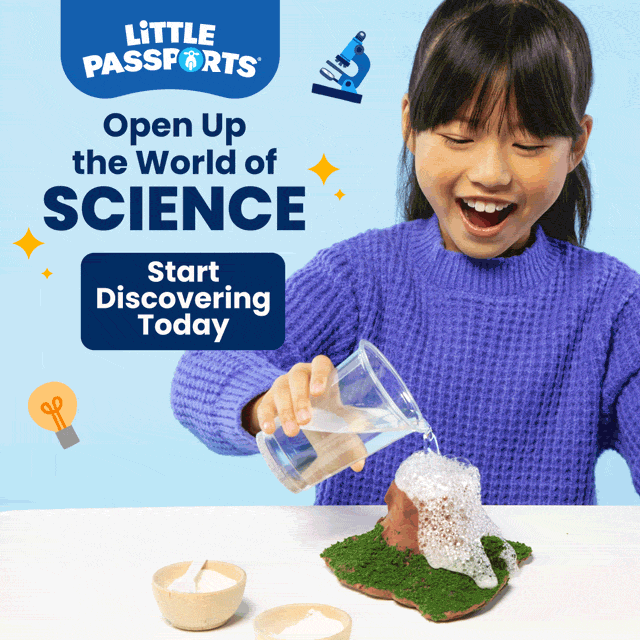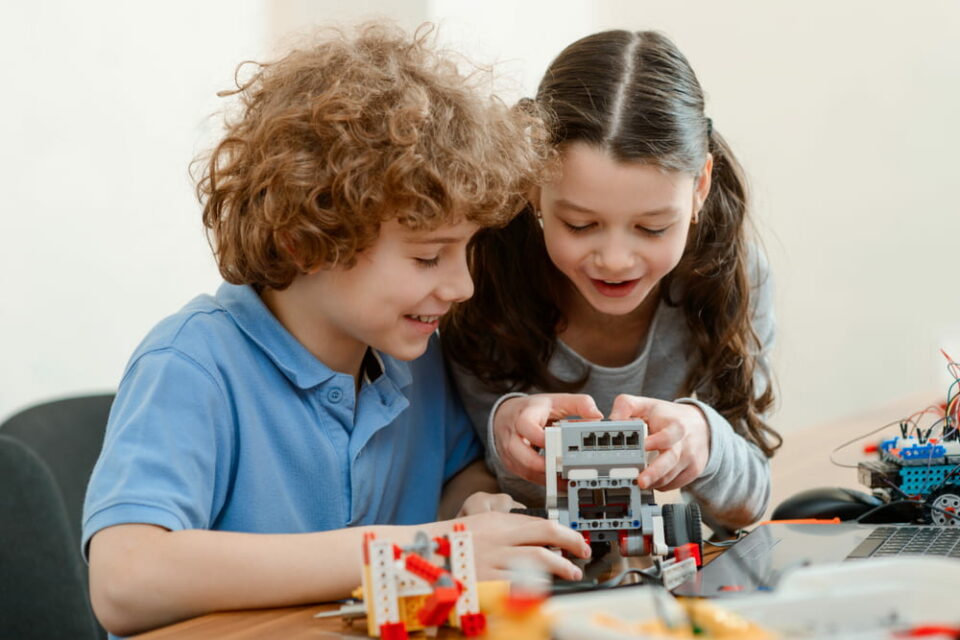
Inspire Discovery with 39 Awesome Science Toys for Kids
Children naturally love discovery and adventure, and their minds crave detailed explanations of just about everything. What were the dinosaurs like? Why is outer space black? Why do bees make honey? What’s dirt made of? That’s why science toys for kids are so great. They can be the perfect companion to a child’s learning. Whatever a kid’s passion—geology, chemistry, biology, or other subjects—age-appropriate science toys will deepen their excitement as they uncover answers to their ever-growing list of questions about the world around them.

STEM (Science, Technology, Engineering, and Mathematics) learning:
- EXPOSES CHILDREN TO NEW IDEAS. Discovering new concepts regularly is one of the best ways to learn. As children encounter new ideas, they develop new interests and ambitions.
- ENHANCES CREATIVE PROBLEM-SOLVING. Science toys and other STEM-centered products for kids challenge kids to think in new ways. The more they play, the more they gain confidence in their abilities and learn to rely on their curiosity, intelligence, and resourcefulness for solutions.
- SHOWS THAT LEARNING IS FUN. The best science toys harness children’s innate curiosity and promote learning. They break down complex concepts into bite-size ideas that kids can explore, and then reinforce what they learned through interactivity and connections to the world kids know. An educational toy helps kids understand learning should be fun, and science-based play can help children begin to see problems as learning opportunities, a skill they will carry into adulthood.
- ENCOURAGE CREATIVITY. STEM-based toys encourage creative thinking and present kids with multiple “what if” scenarios that they have to think through in order to come up with possible outcomes—an invaluable skill!
Fun, creative, educational. What more could you ask for in a child’s toy? Let’s dive in and discover a range of STEM toys for your young scientist.
Science Toy Guide for Kids of All Ages

Depending on your child’s areas of interest, you can find playsets and activity kits that cover a range of topics perfect for their age group. Before you start browsing, talk with your child about what subjects they’re interested in. Then, consult this handy guide to help you find the perfect toy to match their interests and help them dig deeper.
Biology
The natural world contains many opportunities for exploration and discovery. Start your child on their path to understanding our environment and the creatures living in it with toys like:
- Create + Play: Ape Escape kit: Introduce your kid to the fascinating world of Tanzania’s chimpanzees.
- Create + Play: Go, Go, Galápagos kit: Explore the unique animals found exclusively in the Galápagos archipelago.
- Create + Play: Coral Reef kit: Dive in and discover the wonders of the planet’s coral reefs and the underwater creatures that call them home.
- Create + Play: Seal kit: How do animals adapt to extreme cold? Find out by getting to know Weddell Seals and other animals that inhabit Antarctica.
- Animals Wild subscription box: Get to know wondrous creatures all over the planet through hands-on activities, games, and stories.
Chemistry
Chemistry is all about discovering the fundamental building blocks of our planet, so launch your child on an exploration of life, the world, and everything with:
- Ooey Gooey Science: Slime & Big Bubbles: Kids can get their hands dirty and discover the fun chemical properties of soap, rubber, and slime.
- Create + Play: Forensics: Solve a mystery through fingerprints and DNA with this fun introduction to forensic science.
Earth Science
For kids who love digging in the dirt to see what they can find, toys like these can be a gateway to the wonders of geology and more:
- Create + Play: Volcano: Your child will have a blast crafting an erupting volcano and exploring plate tectonics through simulated earthquakes.
- Weather Lab Science Kit: Show your child the natural world’s power with an activity kit that allows them to create a miniature tornado and more.
- 3-D World Puzzle: Get kids fascinated about Earth with this fun-to-assemble globe puzzle that includes colorful stickers and markers.
Anatomy
The human body is a complex machine, and it’s no wonder children are fascinated by it. It won’t take much to encourage them to discover more about its different parts and how they all work together, thanks to toys like these:
- Create + Play: Foosball Kit: Dive into the science of sports to discover how the body’s muscular system works.
Physics
Physics explores how the world works and can help your child discover answers to their favorite question: Why? Get them started with any of these:
- Create + Play: Pinball: The challenges of Newtonian physics come to life in this fun-filled, assemble-and-play pinball game.
- Create + Play: Flight: Explore the principles of flight with this exciting kit that lets kids investigate aerodynamics by creating a wind vane, glider plane, and stunt plane.
Engineering
When scientific principles help us solve real-world problems, it’s engineering! Help your child connect scientific concepts like friction and motion with everyday mechanical marvels.
- Create + Play: Marble Run: Plunge into roller-coaster design by uncovering how the physics of motion come together to engineer everyone’s favorite amusement park thrill.
- Create + Play: Robot: Your child will love uncovering the history of robots, becoming a master computer engineer, and building their own robot that draws.
- Create + Play: Submarine: Take a deep dive into the way these specialized vehicles are helping humans discover the wonders of the Mariana Trench.
If your child doesn’t have a particular passion, you might want to try a science kit with activities that touch on several different STEM topics. Keep their options open and remember to check a toy’s age recommendation before you purchase. The perfect science toy for an eight-year-old may be too advanced for a kindergartener.
Easy Science Toys to Make at Home

Science experiments don’t have to be elaborate. You can put together exciting science activities and toys using everyday items and ingredients found around your home. You can even make scientific toys from trash. Let’s get started!
Miniature Baking Soda Rocket
This one’s a fun collaborative project for you and your child, but it definitely requires an adult’s helping hand. Rescue a plastic soft drink bottle from the recycling bin and plug it with a cork to convert it into a high-flying rocket. Help your child fuel the craft with different amounts of vinegar and baking soda to discover which mix will create the ideal fuel to send the spacecraft farthest into the sky. Start with 2 tablespoons of soda mixed into 1 cup of vinegar and see what happens—depending on the size of the bottle and the fit of the cork, it may create enough pressure to pop the cork off and send the bottle flying! Slowly increase or decrease the amount of baking soda by ½ teaspoon until you’re happy with the results. If your child is more of a junior engineer than a chemist, you can work together to develop different launch pads to see which design gives the smoothest liftoff.
Color-Changing Potions
Discover the joys of chemistry using red cabbage juice, vinegar, and baking soda. Start by chopping cabbage and boiling it in water until the liquid turns purple, and then cool and strain the cabbage potion into a jar, beaker, or glass. Help your child separate the liquid into different containers and then experiment by adding different amounts of baking soda or vinegar to see the results. Chemical reactions between the juice, baking soda, and vinegar should change the color of the liquid.
Absorbing Sugar Cubes
Explore the physical properties of different materials by experimenting with sugar cubes. Pour some water into a plate and help your child add a few drops of food coloring. Mix until the water is a uniform color. Then add a stack of sugar cubes and watch what happens. After a few minutes, the tower of cubes should collapse as the sugar dissolves. Next, see how many cubes the water passes through before the sugar stack falls apart. Then try slipping different materials between the sugar cubes, like plastic wrap, paper towels, coffee filters, or tin foil. What’s the result? Does the water pass through these barriers to dissolve the sugar? Is there a time difference between the various obstacles? What does this tell you about these materials?
Rube Goldberg Machine
A Rube Goldberg machine uses chain reactions to complete tasks, like dropping a ball into a cup that sets off a series of several events that opens a door. These marvelously engineered creations often produce more laughs than results, but they inspire children to think creatively about processes and the concept of cause and effect. Work with your kid to develop your own Rube Goldberg machine. You could create marble runs with old paper towel tubes or build a pulley system with yarn, fishing weights, and dominoes that opens cupboard doors. Use dominoes, string, pipe cleaners, or whatever you have around the house to craft something fun and useful. Some families have even engineered systems that automatically feed the dog!
Hands On!

Science toys come in a variety of forms. Some activities involve constructing simple models, like puzzles, or more complex mechanical systems with many moving parts. Some toys are more experimental, honing your child’s observational skills and exploring basic scientific concepts like cause and effect. But one thing they all have in common is learning by doing, one of the surefire ways to get—and keep—kids engaged.
When your child succeeds in solving a puzzle, they have a sense of accomplishment. If they don’t solve it, they’re encouraged to try again until they get it right. The more they play, the more they discover that problem-solving can be fun.
Adding new toys regularly helps keep the learning experience fresh. The more exposure your child has to a wide variety of STEM-based activities, the better they’ll understand the world around them.
Ready for more STEM-based activities to share with your child? They’ll love blasting into space to explore the moon with an astronaut companion. Pump up playtime’s “ick” factor by whipping up some fluffy slime. Or discover how to create a beautiful rainbow effect using sugar, water, and food coloring. Whatever kids choose, it’s sure to be out-of-this-world fun.
Is your child fascinated by science and technology? If so, they’ll love our Science Junior subscription box. Full of hands-on science activities, stories, and crafts that will keep the discoveries coming, it’s the perfect gift for your young scientist.

